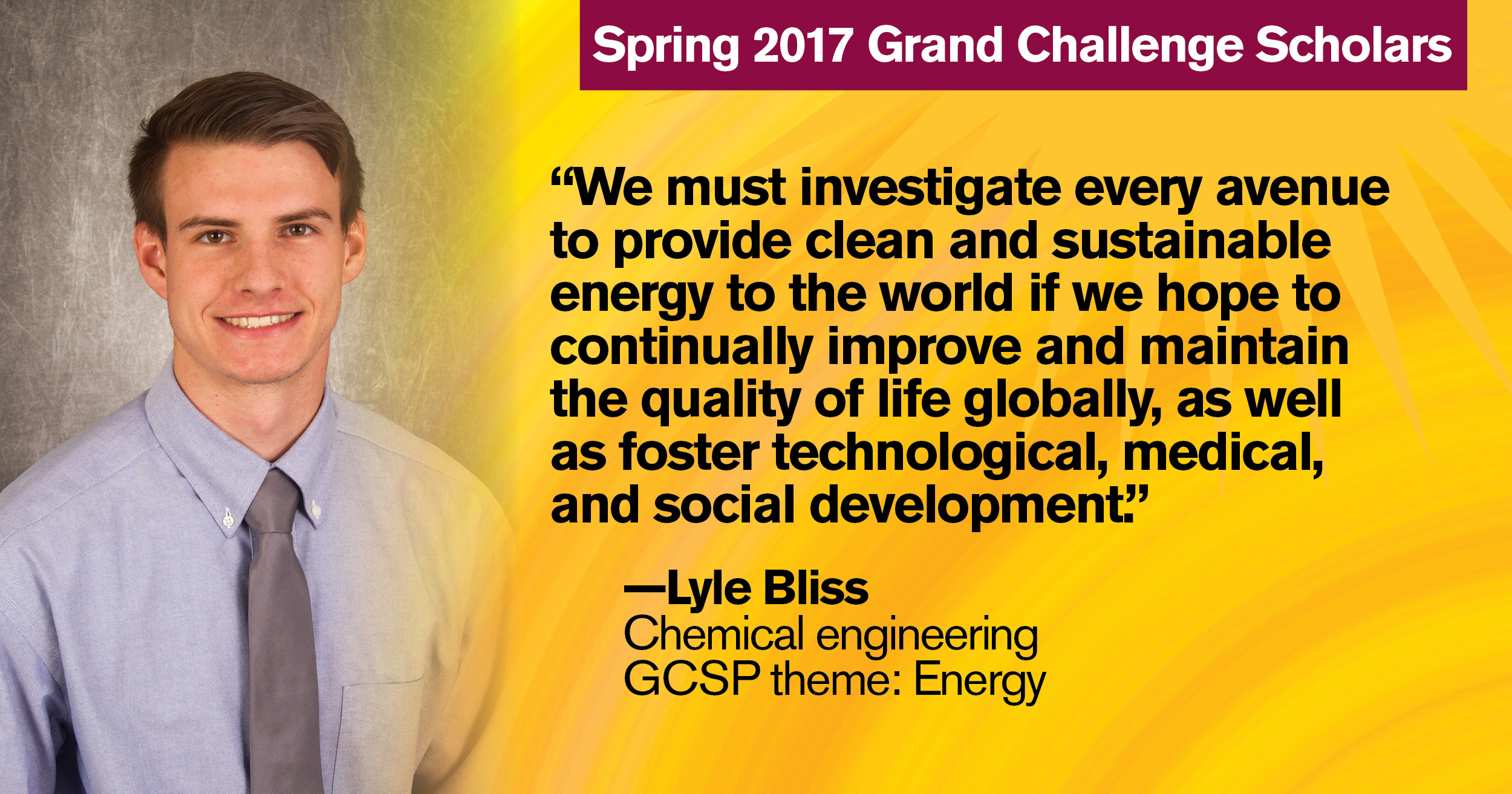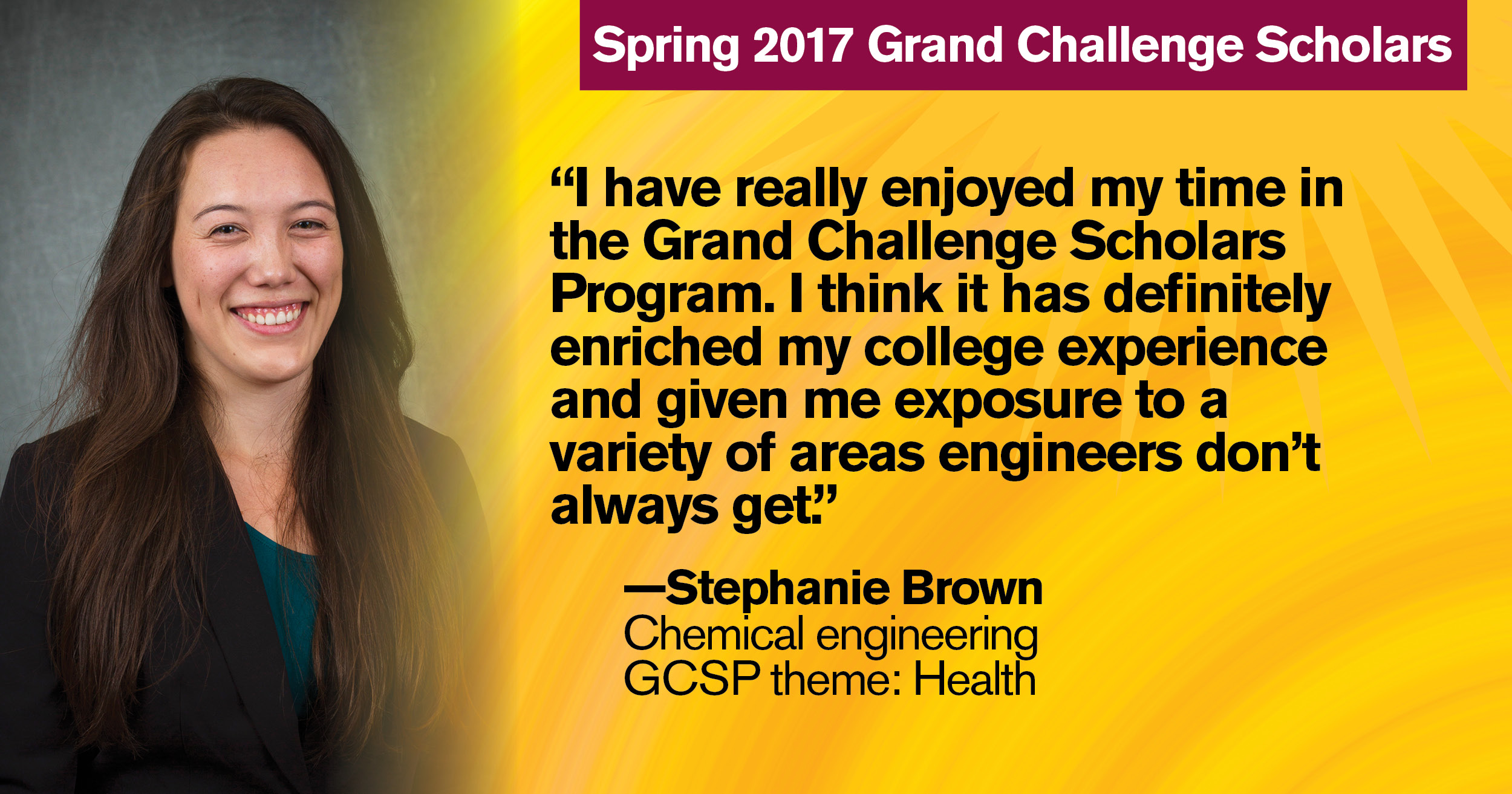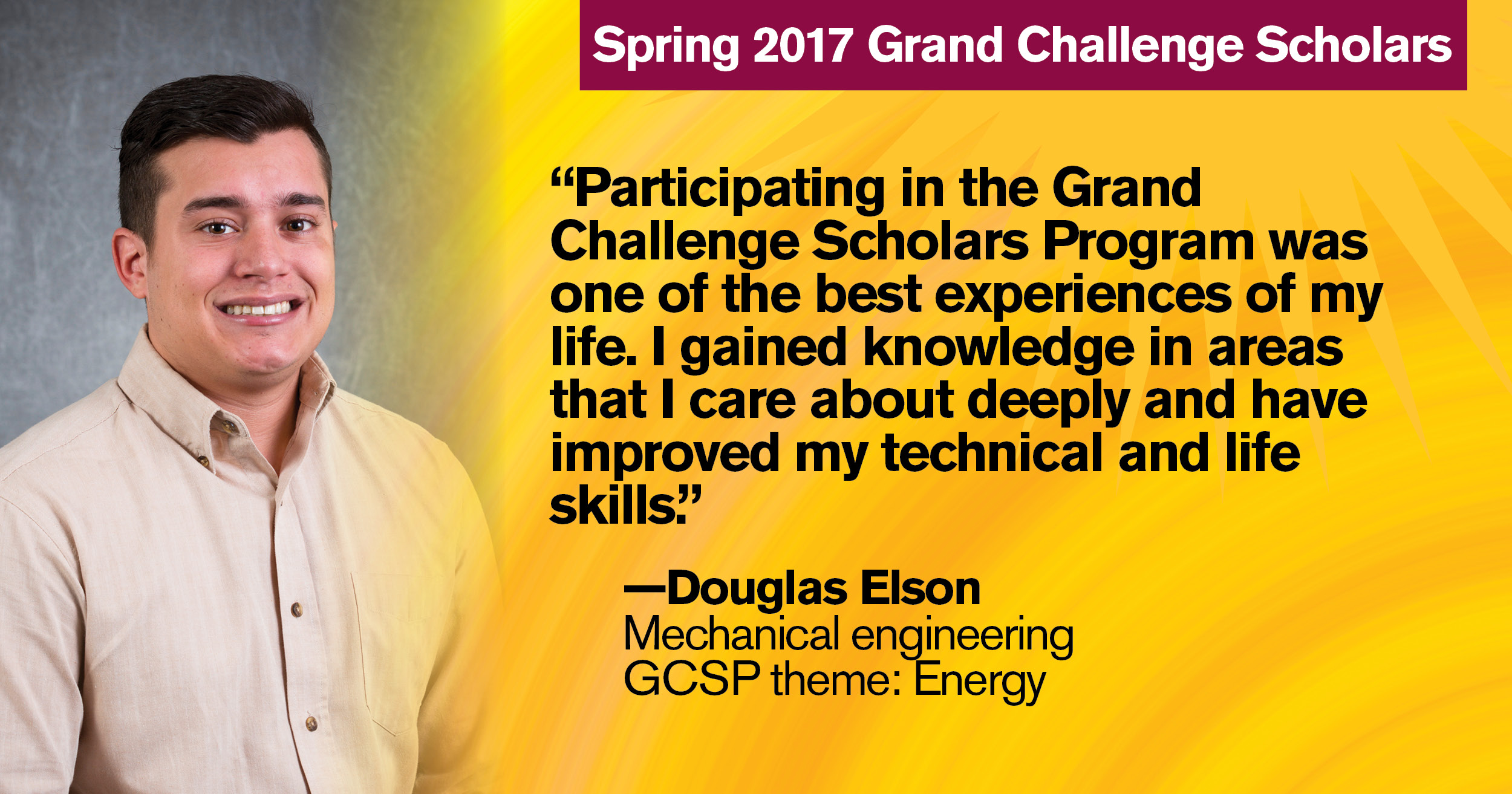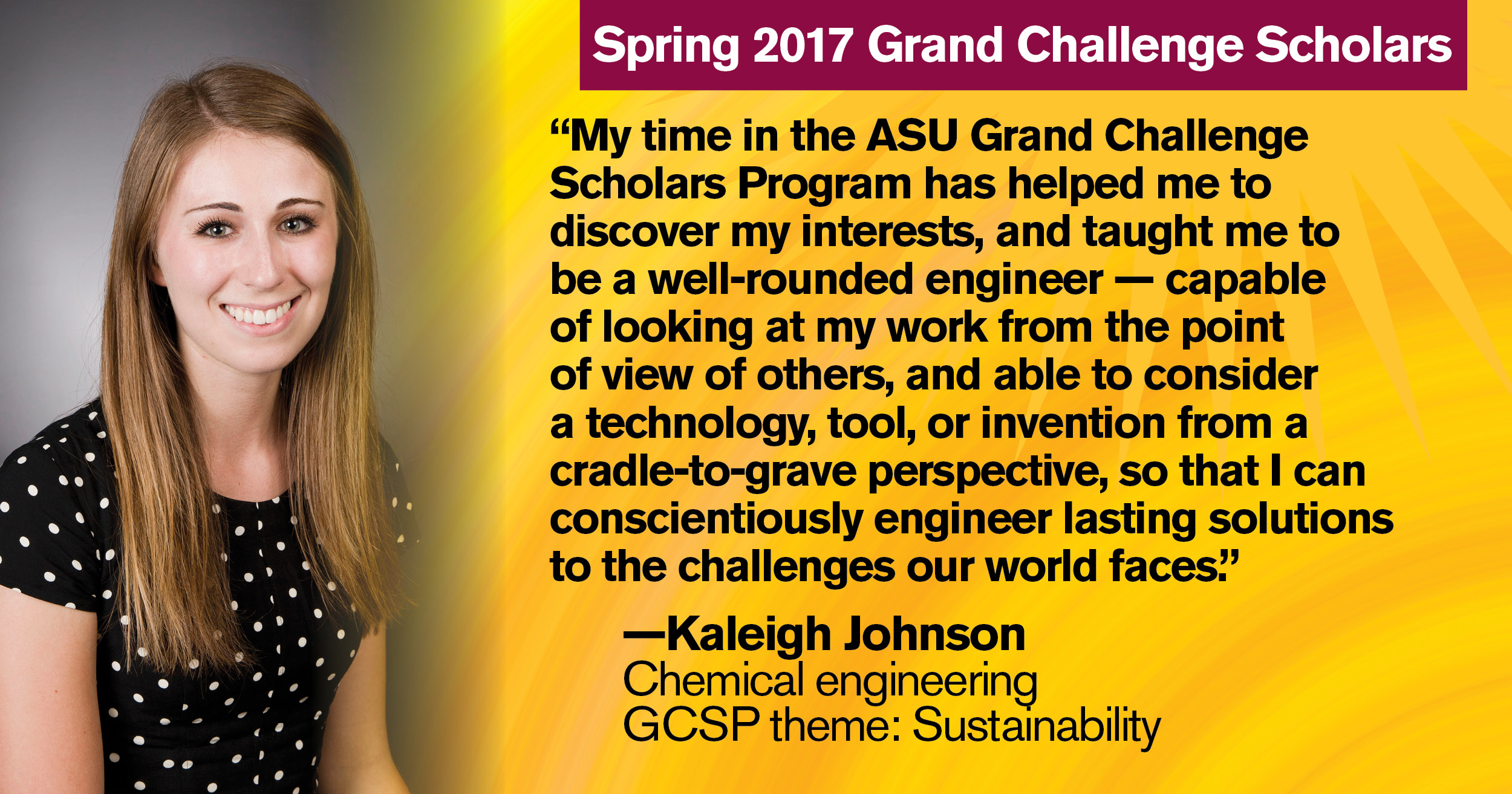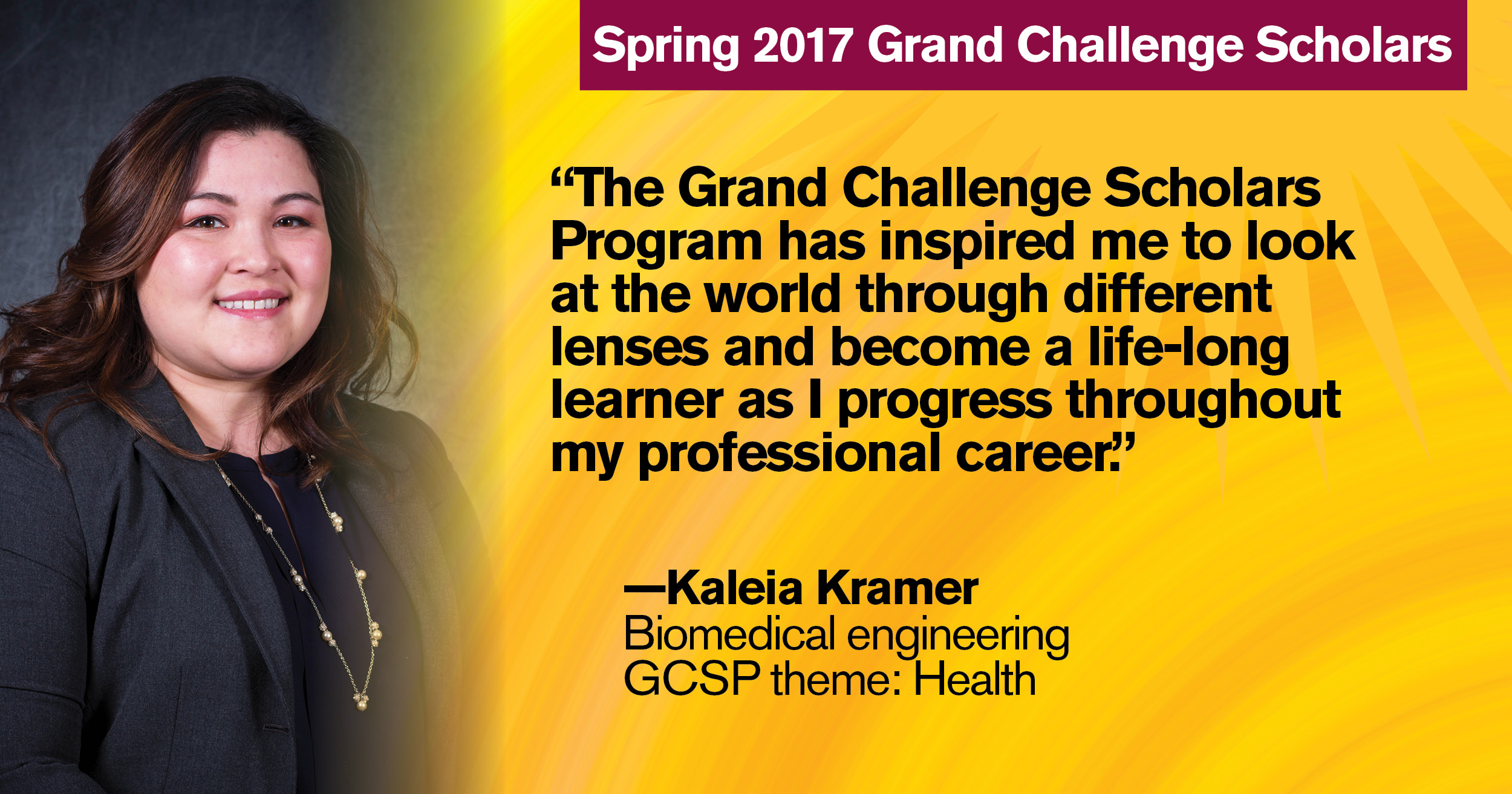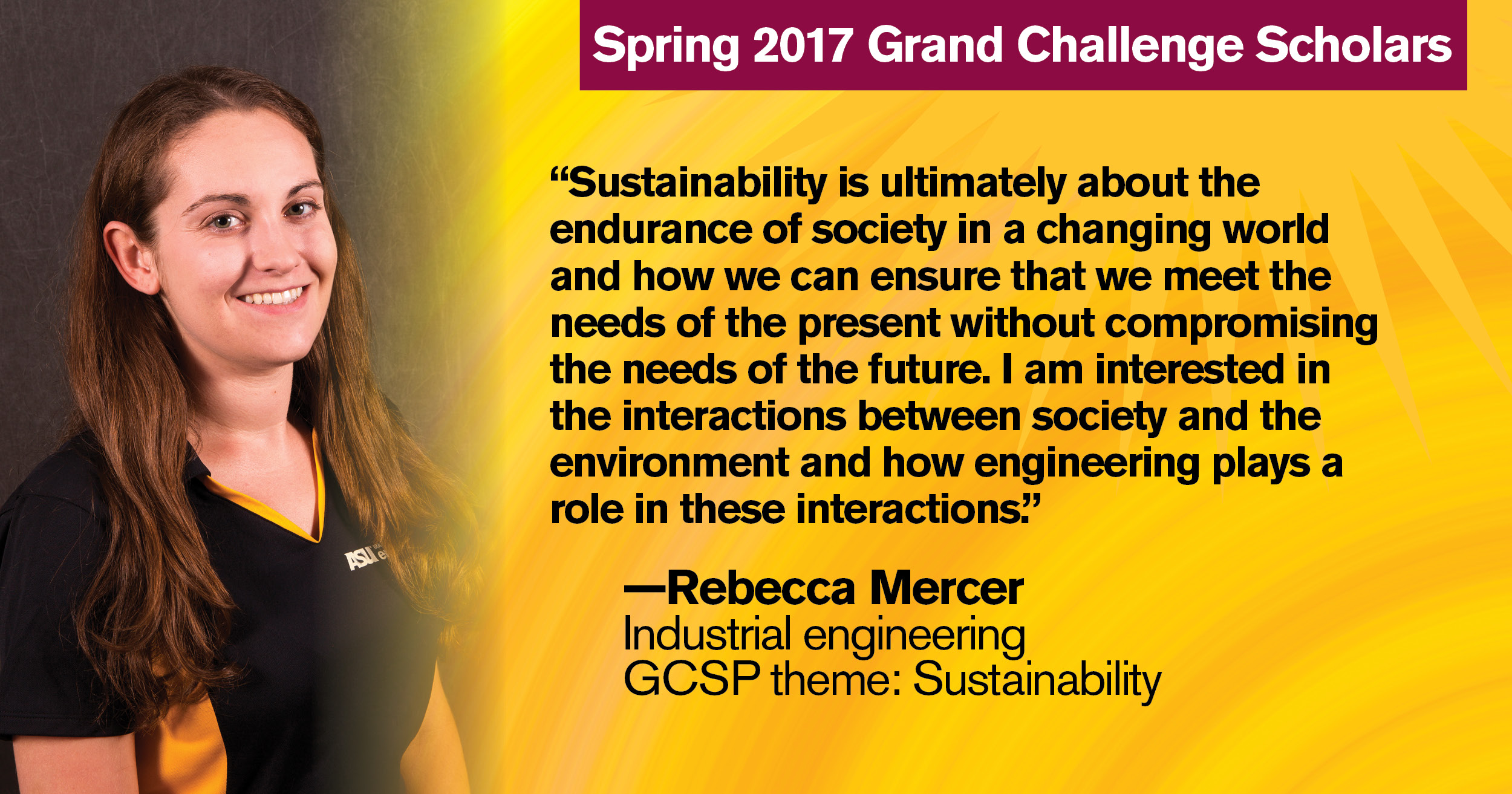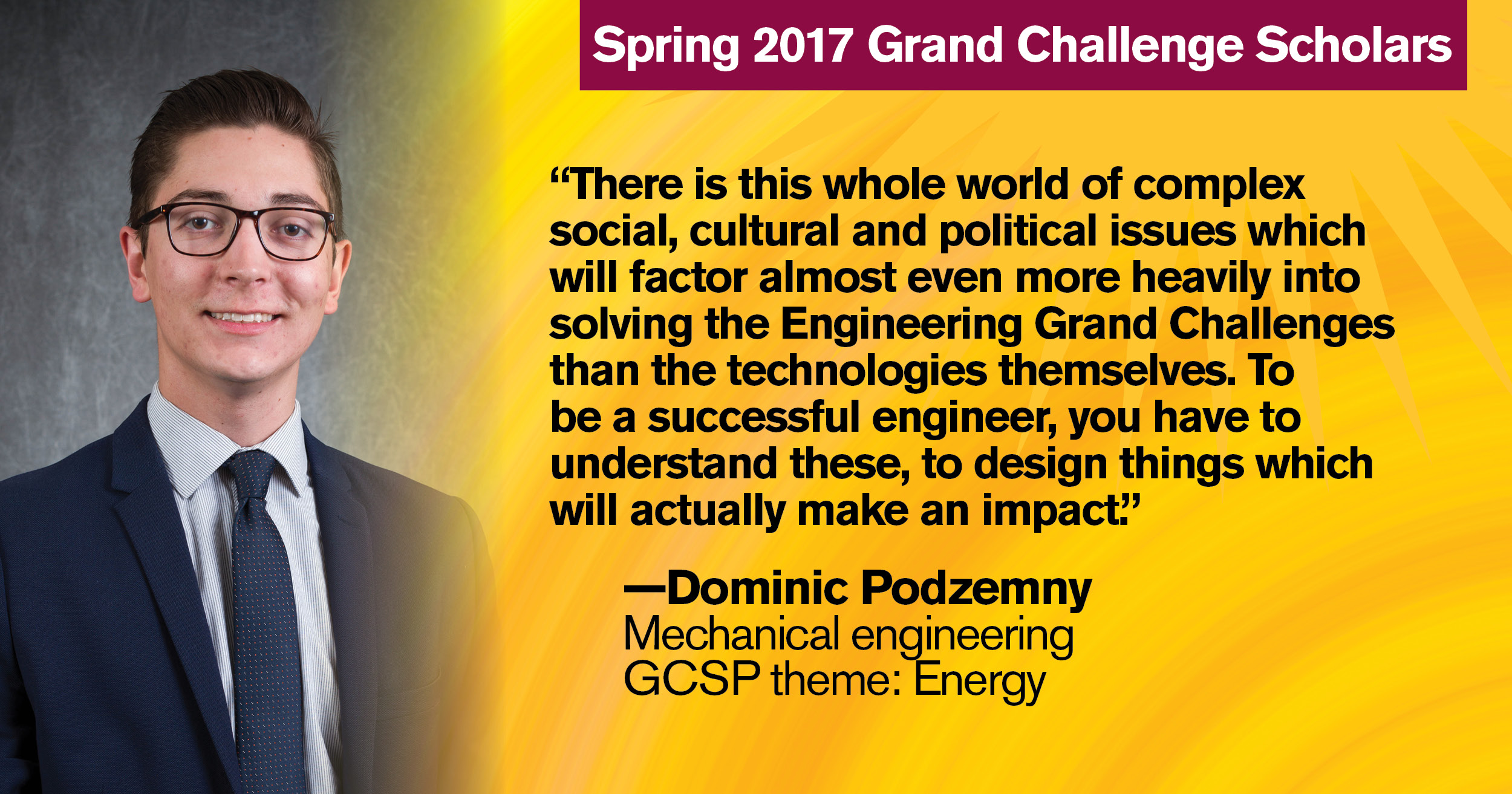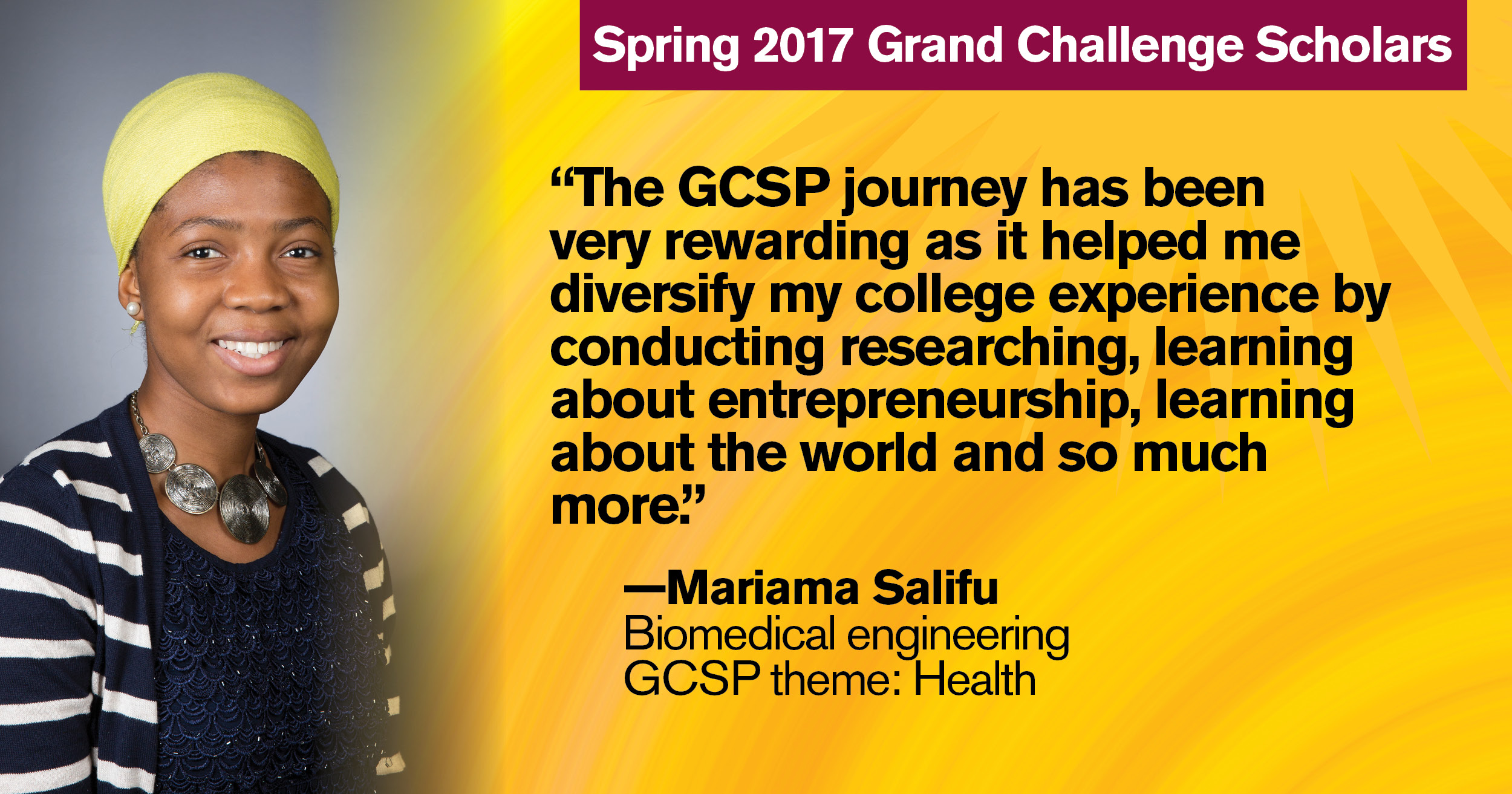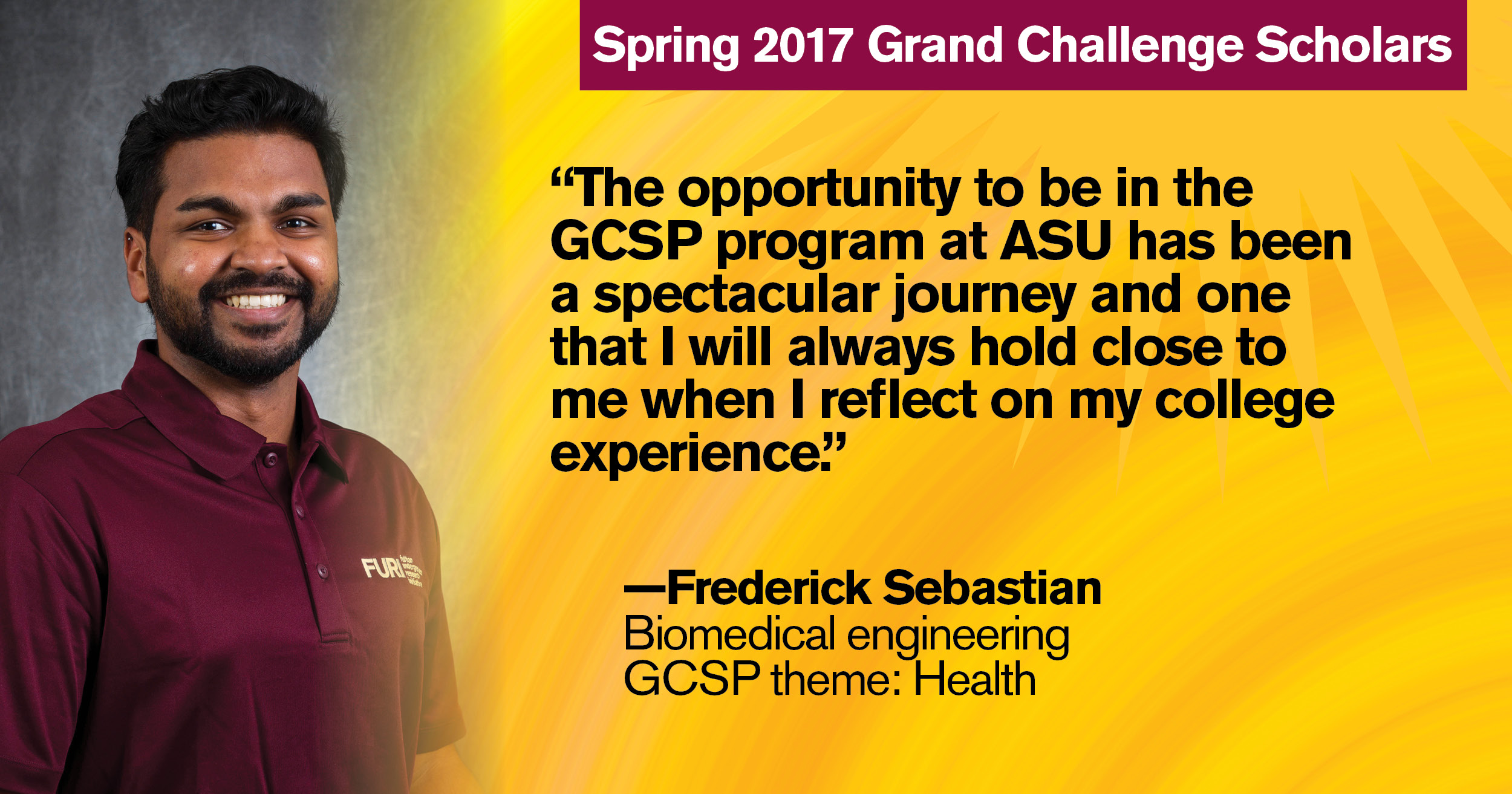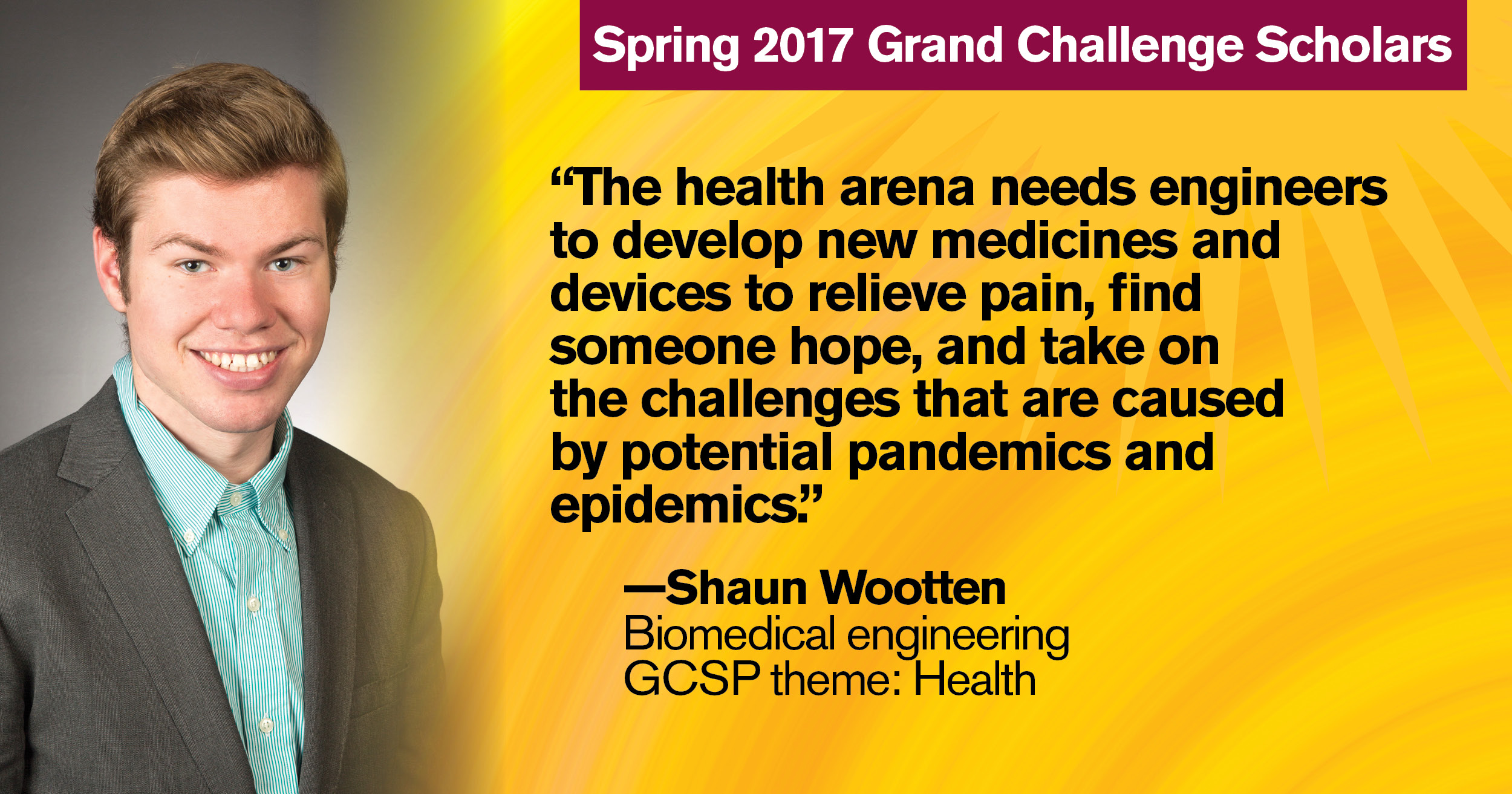
Fulton Schools graduates 17 more Grand Challenge Scholars to tackle global challenges
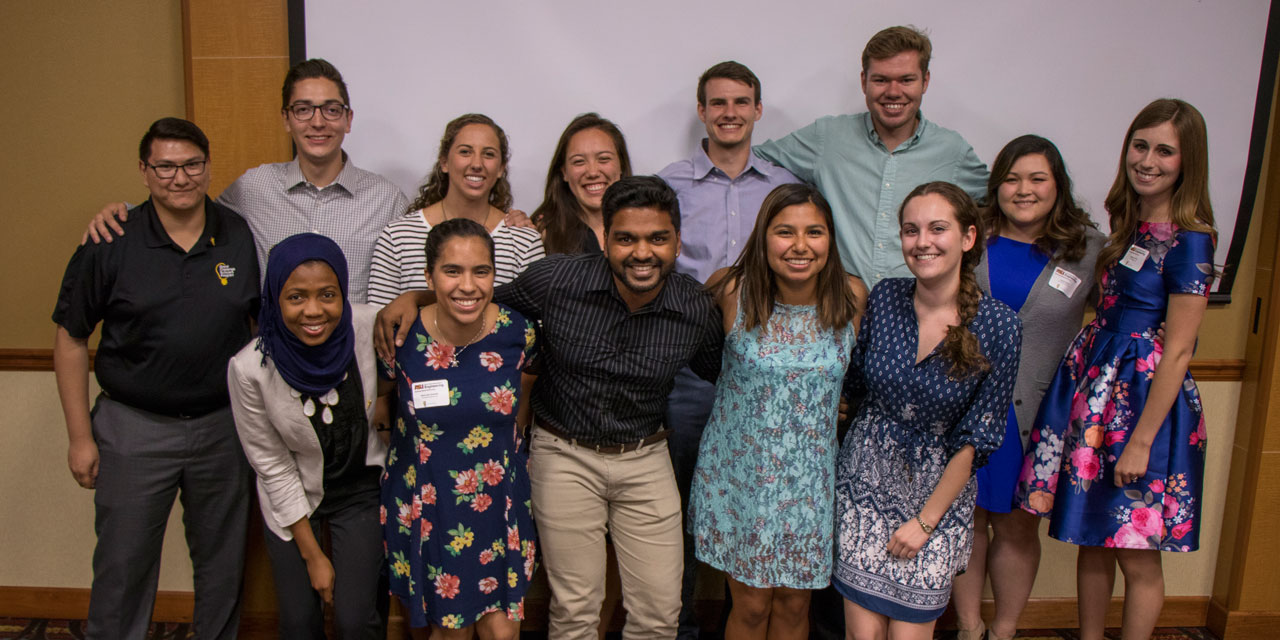
Above: Thirteen of the 17 Grand Challenge Scholars graduating in spring 2017 celebrated at the Grand Challenge Scholars Program Graduation Reception on April 19. This semester’s group is the largest cohort of graduating GCSP students. Photographer: Marco-Alexis Chaira/ASU
Engineers strive to better the world through technology and new ideas. However, engineering alone can’t solve the world’s problems.
High-achieving students in Arizona State University’s Ira A. Fulton Schools of Engineering go above and beyond the typical engineering curriculum in the Grand Challenge Scholars program, as they learn to be collaborative, transdisciplinary, global problem solvers.
This spring, the GCSP program graduated 17 students — the largest cohort yet. These graduates will be added to the official Grand Challenge Scholars Registry.
“I am extremely proud of all the students’ accomplishments, and the people they have become,” says Amy Trowbridge, lecturer and director of the ASU GCSP. “Our graduates this year have published their research in journal articles, started entrepreneurial ventures, immersed themselves in new cultures through studying or implementing projects abroad, and have completed service learning projects that have impacted the community, both locally and globally.”
Students prepare to solve global challenges
The National Academy of Engineering has designated 14 Grand Challenges facing society over the next century.
GCSP scholars choose one of these grand challenge or a broader grand challenge theme — education, energy, health, security or sustainability — and complete five program requirements around that theme.
Students engage in research relating to their selected grand challenge, explore interdisciplinary coursework, gain an international perspective, engage in entrepreneurship, and give back to the community through service learning.
After completing these program requirements, students are designated Grand Challenge Scholars by ASU and the National Academy of Engineering, and added to the official Grand Challenge Scholars Registry.
A growing program
Arizona State University’s Grand Challenge Scholars Program began in 2011 as the largest participating school in the United States.
The program started with about 60 students admitted, and has grown to more than 400 scholars at all levels.
These scholars are a diverse group, with 31 percent female students and 23 percent underrepresented minorities, Trowbridge says.
More than half of GCSP scholars are also in Barrett, the Honors College, and others are Entrepreneurship + Innovation Fellows, both of which are highly ambitious programs that offer a well-rounded experience.
Since the Grand Challenge Scholars Program produced its first graduate in 2013, graduation rates have grown significantly, which Trowbridge believes is due to a variety of factors on the program side and student side.
“Over the past few years we have implemented several efforts to provide opportunities and support for students to enhance their experience and success from their first day in the program,” Trowbridge says, adding that “students have worked hard to provide additional support and opportunities for each other through the affiliated student organization, the Grand Challenge Scholars Alliance.”
Grand Challenges
Advance personalized learning
Make solar energy economical
Enhance virtual reality
Reverse-engineer the brain
Engineer better medicines
Advance health informatics
Restore and improve urban infrastructure
Secure cyberspace
Provide access to clean water
Provide energy from fusion
Prevent nuclear terror
Manage the nitrogen cycle
Develop carbon sequestration methods
Engineer the tools of scientific discovery
32 Grand Challenge Scholars in four years
- 2013 — 1 graduate
- 2015 — 3 graduates
- 2016 — 11 graduates
- 2017 — 17 graduates (and counting…)

Coordinator Senior for Undergraduate Student Engagement Jade Silva, recent biomedical engineering graduate Mariama Salifu and Lecturer and Director of the ASU Grand Challenge Scholars Program Amy Trowbridge. Photographer: Marco-Alexis Chaira/ASU
Jade Silva, coordinator senior for undergraduate student engagement, also credits an increase in dedicated staff and resources to help scholars understand the program’s requirements and how to progress without significantly increasing their course load.
“The focus on adding more staff and faculty support to the program, as well as the summer institute, made it something that was a hands-on learning experience for incoming first-year students into the program,” Silva says.
Support continues for students through checklists, required meetings and degree audits that have a positive effect on keeping students engaged and progressing through program requirements.
“The support from Jade Silva and Amy Trowbridge is overwhelming,” says Kaleia Kramer, a biomedical engineering recent graduate. “They do everything they can to help you succeed, so there is less concern for the students. We can just focus on doing well in the classes.”
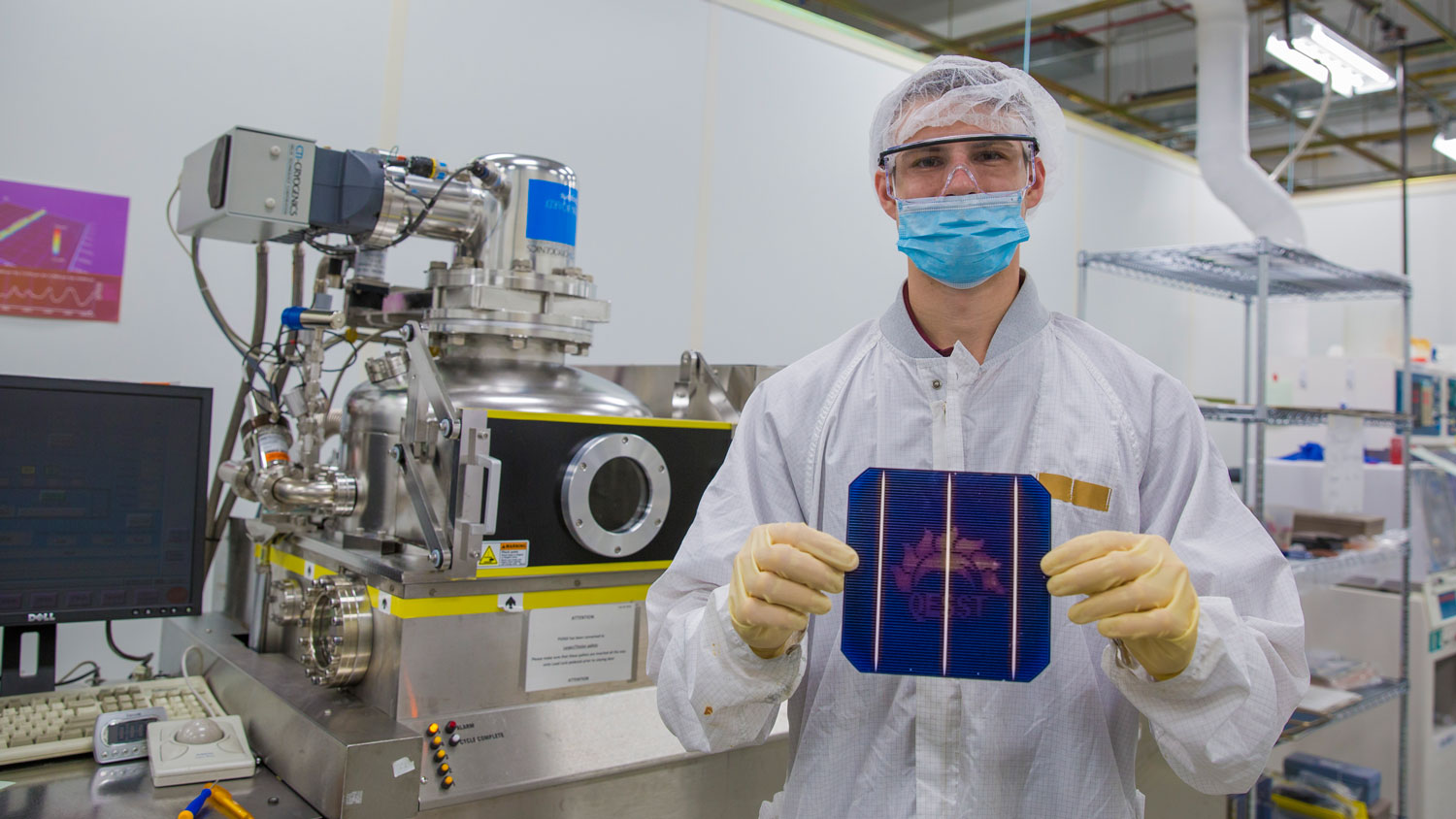
“My best experience within GCSP would definitely be the research I conducted … Through GCSP and FURI I was able to work at ASU’s Solar Power Lab, which I was very interested in, and I ended up learning a great deal from it,” says Lyle Bliss, recent chemical engineering graduate. The Solar Power Lab is a facility utilized by the Quantum Energy and Sustainable Solar Technologies, a National Science Foundation and U.S. Department of Energy Engineering Research Center. Photographer: Jessica Hochreiter/ASU
A dedicated community of scholars
When introduced to the program, students are excited to see the exceptional opportunities GCSP presents.
“I saw that it was a nationally recognized program … and I also liked the emphasis on things such as research and service learning,” says chemical engineering spring 2017 graduate Lyle Bliss.
Students looking for a well-rounded education find that GCSP requirements help them meet their academic goals.
“I decided to apply because I believed it was an amazing program that would help me customize my college experience,” says Mariama Salifu, a recent biomedical engineering graduate. “Having [the GCSP requirements] gave me discipline to do extracurricular activities like research.”
The program also aligns well with activities students are often already involved in, including Engineering Projects in Community Service (EPICS), the Fulton Undergraduate Research Initiatives (FURI) and others.
“The requirements list seemed like the perfect recipe for engineers to be prepared after graduating,” Kramer says. “In addition, most of the requirements were things I was already looking to do — I was already in a research lab, enrolled in EPICS and was very interested in entrepreneurship.”
As students have these positive experiences, word of mouth helps get their peers involved and has led to program growth, Silva says.
A connection between GCSP students in the program is also a key factor to their success, Trowbridge says.
“The students’ connection to each other and the community they built was one of the biggest factors for their success and engagement in the program,” Trowbridge says. “Several of the students have mentioned that staying connected with our ASU GCSP community kept them motivated to succeed in the program.”
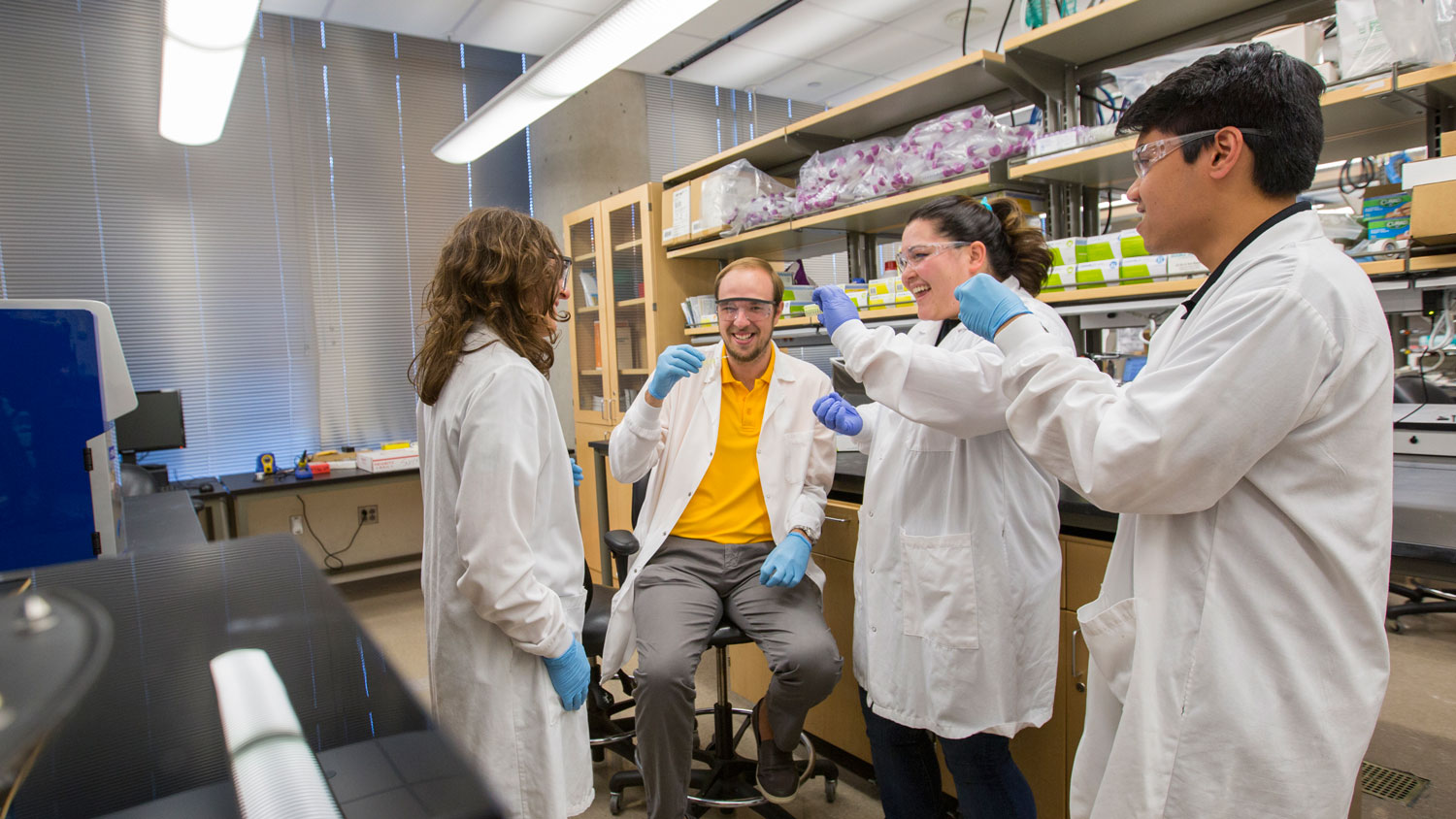
Biomedical engineering research in Assistant Professor Barbara Smith’s lab provided one of many insightful experiences for recent biomedical engineering graduate Kaleia Kramer (second from right). “I have had an incredible experience come out of each facet of the requirements,” Kramer says. “My research qualified me to attend the White House BRAIN Conference, my interdisciplinary component introduced me to the program, piqued my interest and broadened my perspective on engineers. My global component has led me to my upcoming travel to Kenya this summer to implement my capstone project. My entrepreneurial venture led me to travel to Silicon Valley as a Prescott Fellow this spring, and my service learning component has provided me with exposure to real-world projects, problems and solutions that have been invaluable when applying for industry jobs.” Photographer: Jessica Hochreiter/ASU
A once-in-a-lifetime experience
It’s a challenging program, but one that ultimately pays off, Kramer says.
“It wasn’t until my junior year that the rewards of the program started to come back to me,” Kramer says. “As a freshman and a sophomore it seemed like I was just taking extra classes and I could see why some students were dropping out.”
Staying involved in the program provided her with many unique opportunities, including an invitation to the first annual White House BRAIN Conference in 2014, followed by a trip to the Global Grand Challenges Summit in Beijing, China, in 2015.
Scholars graduating this semester have studied global issues, and some even traveled the world, with studies and ventures taking them to Aruba, the United Kingdom, Ghana, Kenya, Israel, India and China.
Students also gained new perspectives on engineering issues through courses across the university in related subjects such as biology and sustainability, but also the seemingly unrelated topics of anthropology, sociology, urban planning, cultural geography, political science and management.
“The experiences that students have as part of GCSP have helped them to better understand how and why they as engineers need to work with people from other disciplines to develop solutions to the interdisciplinary, global problems we face,” Trowbridge says.
These experiences also give them purpose.
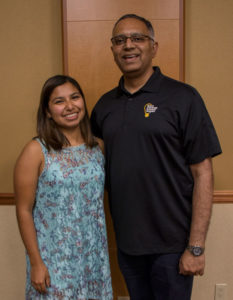
Raquel Camarena, industrial engineering recent graduate, and Tirupalavanam Ganesh, GCSP mentor, associate research professor and Assistant Dean of Engineering Education. Photographer: Marco-Alexis Chaira/ASU
“Students can find meaning — social and personal relevance — in their chosen profession, and know that they can impact the world in significant ways, improving life locally and globally through their work while pursuing their undergraduate degree and beyond,” says Tirupalavanam Ganesh, GCSP mentor, associate research professor and Assistant Dean of Engineering Education.
Kramer and Bliss have obtained internships through the connections they made while completing the program requirements, and feel confident that their experience has prepared them for industry jobs and grad school, respectively.
Finding other callings through GCSP experiences
Though hundreds of students are involved in GCSP, few complete all program requirements, but Silva says this is not an entirely negative outcome.
“When students leave the program, it’s not a loss,” Silva says. “It means that the program did what we wanted it to do — to get students to start to explore, get that experience and find who they want to be as problem solvers.”
In completing research, entrepreneurship, service learning and other requirements, students might find passion in one of the five areas of the GCSP requirements, like an Engineering Projects in Community Service project, a startup, research in a specific faculty member’s lab, or leadership in a student organization.
No matter where they end up, they’re prepared to help the world.
“These students really are the future of engineering and technology, and they are committed to solving some of the world’s toughest problems,” Silva says. “It’s really breaking down this idea that engineers are just technical people, that they are just doing the behind-the-scenes work. These students really understand the importance of what they’re doing, how it impacts society and their role in society. I’m excited to see how they impact the world for the better.”

































